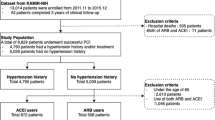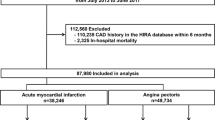Abstract
Background/Aims
Limited comparative data concerning long-term clinical outcomes of combination therapy between beta-blockers (BB) with angiotensin-converting enzyme inhibitors (ACEI) or angiotensin receptor blockers (ARB) therapy in patients with ST-segment elevation myocardial infarction (STEMI) are available. We thought to compare 2-year major clinical outcomes between BB with ACEI and BB with ARB therapy in patients with STEMI after successful percutaneous coronary intervention (PCI) with drug-eluting stents (DES).
Methods
13,873 STEMI patients who underwent successful PCI with DES were enrolled and divided into two groups as the BB with ACEI group (n = 10,393) and the BB with ARB group (n = 3480). The clinical endpoint was the occurrence of major adverse cardiac events (MACE) defined as all-cause death, cardiac death (CD), recurrent myocardial infarction (re-MI), total coronary revascularization (target lesion revascularization [TLR], target vessel revascularization [TVR], non-TVR) during the 2-year follow-up period.
Results
After propensity score-matched (PSM) analysis, two PSM groups (3296 pairs, n = 6592, C-statistic = 0.675) were generated. Although the incidences of re-MI, TLR, and TVR were similar, the incidences of MACE (8.3% vs. 6.8%, log-rank p = 0.038, hazard ratio [HR] 1.210, 95% confidence interval [CI] 1.010–1.451, p = 0.039), all-cause death, CD, total revascularization, and non-TVR of the BB with ARB group were significantly higher than the BB with ACEI group after PSM. In addition, diabetes and multivessel disease were significant predictors for non-TVR.
Conclusions
The combination BB with ACEI may be beneficial for reducing MACE in STEMI patients after successful PCI with DES than the BB with ARB.




Similar content being viewed by others
Abbreviations
- AMI:
-
Acute myocardial infarction
- STEMI:
-
ST-segment elevation myocardial infarction
- DES:
-
Drug-eluting stent
- EES:
-
Everolimus-eluting stent
- MACE:
-
Major adverse cardiac event
- PCI:
-
Percutaneous coronary intervention
- PES:
-
Paclitaxel-eluting stent
- SES:
-
Sirolimus-eluting stent
- TLR:
-
Target lesion revascularization
- TVR:
-
Target vessel revascularization
- Non-TVR:
-
Non-target vessel revascularization
- ZES:
-
Zotarolimu-eluting stent
References
American College of Emergency Physicians; Society for Cardiovascular Angiography and Interventions, O'Gara PT, Kushner FG, Ascheim DD, Casey DE Jr, Chung MK, et al. 2013 ACCF/AHA guideline for the management of ST-elevation myocardial infarction: a report of the American College of Cardiology Foundation/American Heart Association Task Force on Practice Guidelines. J Am Coll Cardiol. 2013;61:e78–140.
Freemantle N, Cleland J, Young P, Mason J, Harrison J. Beta-blockade after myocardial infarction: systematic review and meta regression analysis. BMJ. 1999;318:1730–7.
Ibanez B, James S, Agewall S, Antunes MJ, Bucciarelli-Ducci C, Bueno H, et al. 2017 ESC Guidelines for the management of acute myocardial infarction in patients presenting with ST-segment elevation: the task force for the management of acute myocardial infarction in patients presenting with ST-segment elevation of the European Society of Cardiology (ESC). Eur Heart J. 2018;39:119–77.
Cleland JG, Erhardt L, Murray G, Hall AS, Ball SG. Effect of ramipril on morbidity and mode of death among survivors of acute myocardial infarction with clinical evidence of heart failure. A report from the AIRE Study Investigators. Eur Heart J. 1997;18:41–51.
Nishino T, Furukawa Y, Kaji S, Ehara N, Shiomi H, Kim K, et al. Distinct survival benefits of angiotensin-converting enzyme inhibitors/angiotensin II receptor blockers in revascularized coronary artery disease patients according to history of myocardial infarction. Circ J. 2013;77:1242–52.
Pfeffer MA, McMurray J, Leizorovicz A, Maggioni AP, Rouleau JL, Van De Werf F, et al. Valsartan in acute myocardial infarction trial (VALIANT): rationale and design. Am Heart J. 2000;140:727–50.
Yang JH, Hahn JY, Song YB, Choi SH, Choi JH, Lee SH, et al. Angiotensin receptor blocker in patients with ST segment elevation myocardial infarction with preserved left ventricular systolic function: prospective cohort study. BMJ. 2014;349:g6650.
O'Gara PT, Kushner FG, Ascheim DD, Casey DE Jr, Chung MK, de Lemos JA, et al. 2013 ACCF/AHA guideline for the management of ST-elevation myocardial infarction: a report of the American College of Cardiology Foundation/American Heart Association Task Force on Practice Guidelines. Circulation. 2013;127:e362–425.
López-Sendón J, Swedberg K, McMurray J, Tamargo J, Maggioni AP, Dargie H, et al. Expert consensus document on beta-adrenergic receptor blockers. Eur Heart J. 2004;25:1341–62.
Smith SC Jr, Blair SN, Bonow RO, Brass LM, Cerqueira MD, Dracup K, et al. AHA/ACC Scientific Statement: AHA/ACC guidelines for preventing heart attack and death in patients with atherosclerotic cardiovascular disease: 2001 update: a statement for healthcare professionals from the American Heart Association and the American College of Cardiology. Circulation. 2001;104:1577–9.
Chen ZM, Panc HC, Chen YP, Peto R, Collins R, Jiang LX, Xie JX, Liu LS; COMMIT (ClOpidogrel and Metoprolol in Myocardial Infarction Trial) collaborative group. Early intravenous then oral metoprolol in 45,852 patients with acute myocardial infarction: randomized placebo-controlled trial. Lancet. 2005;366:1622–32.
Pfisterer M, Cox JL, Granger CB, Brener SJ, Naylor CD, Califf RM, et al. Atenolol use and clinical outcomes after thrombolysis for acute myocardial infarction: the GUSTO-I experience. Global Utilization of Streptokinase and TPA (alteplase) for Occluded Coronary Arteries. J Am Coll Cardiol. 1998;32:634–40.
Andersson C, Shilane D, Go AS, Chang TI, Kazi D, Solomon MD, et al. β-blocker therapy and cardiac events among patients with newly diagnosed coronary heart disease. J Am Coll Cardiol. 2014;64:247–52.
Ball SG, Hall AS, Murray GD. ACE inhibition, atherosclerosis and myocardial infarction—the AIRE Study in practice. Acute Infarction Ramipril Efficacy Study. Eur Heart J. 1994;15(Suppl B):20–5 discussion 26–30.
Pfeffer MA, Braunwald E, Moye LA, Basta L, Brown EJ Jr, Cuddy TE, et al. Effect of captopril on mortality and morbidity in patients with left ventricular dysfunction after myocardial infarction. Results of the survival and ventricular enlargement trial. The SAVE investigators. N Engl J Med. 1992;327:669–77.
Flather MD, Yusuf S, Kober L, Pfeffer M, Hall A, Murray G, et al. Long-term ACE-inhibitor therapy in patients with heart failure or left-ventricular dysfunction: a systematic overview of data from individual patients. ACE-Inhibitor Myocardial Infarction Collaborative Group. Lancet. 2000;355:1575–81.
Probstfield JL, O'Brien KD. Progression of cardiovascular damage: the role of renin-angiotensin system blockade. Am J Cardiol. 2010;105:10a–20a.
Heart Outcomes Prevention Evaluation (HOPE) Study Investigators. Effects of ramipril on cardiovascular and microvascular outcomes in people with diabetes mellitus: results of the HOPE study and MICRO-HOPE substudy. Lancet. 2000;355:253–9.
The Acute Infarction Ramipril Efficacy (AIRE) Study Investigators. Effect of ramipril on mortality and morbidity of survivors of acute myocardial infarction with clinical evidence of heart failure. Lancet. 1993;342:821–8.
Strauss MH, Hall AS. Angiotensin receptor blockers may increase risk of myocardial infarction: unraveling the ARB-MI paradox. Circulation. 2006;114:838–54.
Verma S, Strauss M. Angiotensin receptor blockers and myocardial infarction. BMJ. 2004;329:1248–9.
Ramchand J, Patel SK, Srivastava PM, Farouque O, Burrell LM. Elevated plasma angiotensin converting enzyme 2 activity is an independent predictor of major adverse cardiac events in patients with obstructive coronary artery disease. PLoS One. 2018;13:e0198144.
Park H, Kim HK, Jeong MH, Cho JY, Lee KH, Sim DS, et al. Clinical impacts of inhibition of renin-angiotensin system in patients with acute ST-segment elevation myocardial infarction who underwent successful late percutaneous coronary intervention. J Cardiol. 2017;69:216–21.
Zweifler A, Esler M. Blood pressure, renin activity and heart rate changes during propranolol therapy of hypertension. Am J Cardiol. 1977;40:105–9.
Konishi M, Haraguchi G, Yoshikawa S, Kimura S, Inagaki H, Isobe M. Additive effects of beta-blockers on renin-angiotensin system inhibitors for patients after acute myocardial infarction treated with primary coronary revascularization. Circ J. 2011;75:1982–91.
Savarese G, Costanzo P, Cleland JG, Vassallo E, Ruggiero D, Rosano G, et al. A meta-analysis reporting effects of angiotensin-converting enzyme inhibitors and angiotensin receptor blockers in patients without heart failure. J Am Coll Cardiol. 2013;61:131–42.
Lee PH, Park GM, Kim YH, Yun SC, Chang M, Roh JH, et al. Effect of beta blockers and renin-angiotensin system inhibitors on survival in patients with acute myocardial infarction undergoing percutaneous coronary intervention. Medicine (Baltimore). 2016;95:e2971.
McMurray J, Solomon S, Pieper K, Reed S, Rouleau J, Velazquez E, et al. The effect of valsartan, captopril, or both on atherosclerotic events after acute myocardial infarction: an analysis of the Valsartan in Acute Myocardial Infarction Trial (VALIANT). J Am Coll Cardiol. 2006;47:726–33.
Spitaleri G, Moscarella E, Brugaletta S, Pernigotti A, Ortega-Paz L, Gomez-Lara J, et al. Correlates of non-target vessel-related adverse events in patients with ST-segment elevation myocardial infarction: insights from five-year follow-up of the EXAMINATION trial. EuroIntervention. 2018;13:1939–45.
Hong MK, Mintz GS, Lee CW, Kim YH, Lee SW, Song JM, et al. Comparison of coronary plaque rupture between stable angina and acute myocardial infarction: a three-vessel intravascular ultrasound study in 235 patients. Circulation. 2004;110:928–33.
Stone GW, Maehara A, Lansky AJ, de Bruyne B, Cristea E, Mintz GS, et al. A prospective natural-history study of coronary atherosclerosis. N Engl J Med. 2011;364:226–35.
Farkouh ME, Domanski M, Sleeper LA, Siami FS, Dangas G, Mack M, et al. FREEDOM Trial Investigators. Strategies for multivessel revascularization in patients with diabetes. N Engl J Med. 2012;367:2375–84.
Jimenez-Quevedo P, Hernando L, Gomez-Hospital JA, Iñiguez A, SanRoman A, Alfonso F, et al. Sirolimus-eluting stent versus bare metal stent in diabetic patients: the final five-year follow-up of the DIABETES trial. EuroIntervention. 2013;9:328–35.
Park DW, Clare RM, Schulte PJ, Pieper KS, Shaw LK, Califf RM, et al. Extent, location, and clinical significance of non-infarct-related coronary artery disease among patients with ST-elevation myocardial infarction. JAMA. 2014;312:2019–27.
Jaski BE, Cohen JD, Trausch J, Marsh DG, Bail GR, Overlie PA, et al. Outcome of urgent percutaneous transluminal coronary angioplasty in acute myocardial infarction: comparison of single-vessel versus multivessel coronary artery disease. Am Heart J. 1992;124:1427–33.
Westreich D, Cole SR, Funk MJ, Brookhart MA, Sturmer T. The role of the c-statistic in variable selection for propensity score models. Pharmacoepidemiol Drug Saf. 2011;20:317–20.
Acknowledgements
Korea Acute Myocardial infarction Registry (KAMIR) investigators.
Myung Ho Jeong, MD; Youngkeun Ahn, MD; Sung Chul Chae, MD; Jong Hyun Kim, MD; Seung-Ho Hur, MD; Young Jo Kim, MD; In Whan Seong, MD; Donghoon Choi, MD; Jei Keon Chae, MD; Taek Jong Hong, MD; Jae Young Rhew, MD; Doo-Il Kim, MD; In-Ho Chae, MD; Jung Han Yoon, MD; Bon-Kwon Koo, MD; Byung-Ok Kim, MD; Myoung Yong Lee, MD; Kee-Sik Kim, MD; Jin-Yong Hwang, MD; Myeong Chan Cho, MD; Seok Kyu Oh, MD; Nae-Hee Lee, MD; Kyoung Tae Jeong, MD; Seung-Jea Tahk, MD; Jang-Ho Bae, MD; Seung-Woon Rha, MD; Keum-Soo Park, MD; Chong Jin Kim, MD; Kyoo-Rok Han, MD; Tae Hoon Ahn, MD; Moo-Hyun Kim, MD; Ki Bae Seung, MD; Wook Sung Chung, MD; Ju-Young Yang, MD; Chong Yun Rhim, MD; Hyeon-Cheol Gwon, MD; Seong-Wook Park, MD; Young-Youp Koh, MD; Seung Jae Joo, MD; Soo-Joong Kim, MD; Dong Kyu Jin, MD; Jin Man Cho, MD; Sang-Wook Kim, MD; Jeong Kyung Kim, MD; Tae Ik Kim, MD; Deug Young Nah, MD; Si Hoon Park, MD; Sang Hyun Lee, MD; Seung Uk Lee, MD; Hang-Jae Chung, MD; Jang-Hyun Cho, MD; Seung Won Jin, MD; Myeong-Ki Hong, MD; Yangsoo Jang, MD; Jeong Gwan Cho, MD; Hyo-Soo Kim, MD; and Seung Jung Park, MD.
Funding
This research was supported by a fund (2016-ER6304-02) by Research of Korea Centers for Disease Control and Prevention.
Author information
Authors and Affiliations
Corresponding author
Ethics declarations
Conflict of Interest
The authors declare that they have no competing interests.
Ethical Approval
All procedures performed in studies involving human participants were in accordance with the ethical standards of the institutional and/or national research committee and with the 1964 Helsinki declaration and its later amendments or comparable ethical standards.
Additional information
Publisher’s Note
Springer Nature remains neutral with regard to jurisdictional claims in published maps and institutional affiliations.
Rights and permissions
About this article
Cite this article
Kim, Y.H., Her, AY., Jeong, M.H. et al. Comparison Between Beta-Blockers with Angiotensin-Converting Enzyme Inhibitors and Beta-Blockers with Angiotensin II Type I Receptor Blockers in ST-Segment Elevation Myocardial Infarction After Successful Percutaneous Coronary Intervention with Drug-Eluting Stents. Cardiovasc Drugs Ther 33, 55–67 (2019). https://doi.org/10.1007/s10557-018-6841-7
Published:
Issue Date:
DOI: https://doi.org/10.1007/s10557-018-6841-7




